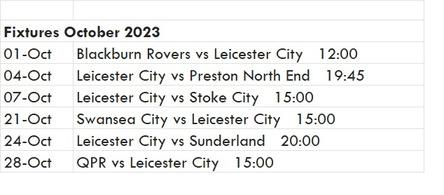UN-OFFICIAL LEICESTER CITY










After an unprecedented August of success for Enzo’s swaggering Leicester City, a trickier September loomed on the horizon with sterner questions to be asked. Could Leicester City maintain their 100% record? Which players would show commitment to the cause after the transfer window? And would the Foxes improve on their 4-0 pre-season thrashing by Liverpool in the EFL cup?

2nd September - Foxes 0 Tigers (not the rugby) 1 - Championship
First question answered then, no the 100% record did not last long into September. Liam Delap’s deflected strike settled the match for Liam Rosenior’s men. Not for the want of trying, as the Foxes could have taken something here with better finishing from Cesare Casadei and Jamie Vardy both agonisingly close. A slice of luck could have gone their way as on-loan winger Abdul Fatawu cut into the box before crashing a low shot against the post.
The Foxes dominated possession as usual but their casual approach to jeopardy perhaps cost them slightly here as the sense of urgency to get back into the game never quite materialised. It is to be expected though, this is only the second time they have trailed a match this season. But going into the international break they had won six out of seven games. Not too shabby after the car crash of last season.
15th September – Saints 1 Foxes 4 - Championship
No Friday night away victory on any south coast will ever be as good as that one in 2019, but this was still a thoroughly enjoyable way to return to winning ways.
Roughly 25 seconds was all the Southampton fans were able to enjoy in terms of parity as serial tormentor Jamie Vardy opened his league account for the season to stun the St Mary’s crowd. Most significantly in that build up was Stephy Mavididi, who caused Russell Martin’s team all sorts of problems throughout the game. He set up the third goal with great persistence and poise to an unrecognisably skilful Wilfred Ndidi who weaved into the box and finished with class and composure.
Mavdidi continued his tormenting throughout and not just to his opponents. His own teammates were getting wound up by him, as he should have played Jamie Vardy in for an open goal tap-in that went wide. He followed that up by not giving Kiernan DewsburyHall the ball, but instead produced a glossy finish to put the game to bed. Mavididi is becoming a fan favourite, but he will need to get better at decisive moments in games to become a player that could cause havoc at this level.
Let’s also not forget some other players who although not grabbing headlines have had extraordinary starts to the season. Kasey McAteer produced another excellent run and finish to cap a fine performance in his breakthrough season. Whilst Jannik Vestergaard, a man whose forgettable Leicester City career appeared to be over long ago has been given a new lease of life, he’s now keeping Connor Coady on the bench as he pulls out consistently solid performances. It’s amazing what a player can do when treated right by his coaching staff.
One key part of this emphatic victory, lies in the statistics. This was the first time this season that the Foxes had surrendered possession stats and indeed, made fewer passes than their opponents. Beware any team that tries to take this side on at their own game.
From Southampton to Norfolk, Leicester continued their impressive form at Carrow Road, which was no small feat when considering the opposition had a 100% home record. Changes were made with Iheanacho switching with Vardy, Choudhury taking in the tricky inverted full back/defensive midfield position, whilst Yunus Akgun and Cesare Casadei replaced Ndidi and Dewsbury-Hall in the attacking number eight positions.

A cagey first half saw the game only separated by Leicester’s first penalty of the season after Stephy Mavididi was upended. Kelechi Iheanacho fired into the roof of the net much to the annoyance of the home faithful. Mavididi could also have put some gloss on the score line heading into half time, but his spritely run ended in a shot going narrowly wide.
This ignited David Wagner’s men into action in the second half as they went in search of an equaliser. Shane Duffy’s solid header was saved dramatically by Mads Hermansen for one of the best saves so far this season. Not long after Hermansen gave the ball away deep in Foxes territory, Kenny McLean snapped up the ball and side footed a long-range strike against the crossbar. Lady luck was smiling on Enzo Maresca’s men.
Kasey McAteer should have then added to his tally but misplaced an open goal header over the bar. He didn’t have long to wait to make amends as Dewsbury-Hall opened his body out from a neat first touch and unselfishly (take note Mavididi) timed a pass perfectly for McAteer to tap in his fourth Leicester City goal. The 100% away record continued as the club continued their impressive form and gave Mads Hermansen his first Leicester City clean sheet.
Hermansen’s next clean sheet didn’t have long to wait. A well organised Robins side made life tricky without ever truly threatening their opponents as Leicester produced a solid defensive display. Fatawu, Mavididi and Dewsbury-Hall all went close on occasions. The eventual goal came from another penalty with Wilfred Ndidi once again proving a problem for opponents being tripped from a lazy leg from Kai Naismith. Jamie Vardy gleefully stepped up to notch his third goal of the season before running all the way to the away end to mock their support who had previously tried to wind him up. Another three points in the bag to send Leicester to the top of the league.
In truth, many of the Leicester City sentimentalists pencilled the visit of Bristol City as for many this was an opportunity to say ‘Thank you’ to some true Foxes greats that have earned their place in Leicester City history, including Dave Rennie and Matty James. But the main adolation was given to Andy King and Nigel Pearson. King fought back the tears as the home support sang his name loud and proud. The normally stoic Pearson had a similar moment of emotion The impact he had on the club’s success will live long in the memory, taking them from the lowest point in their history and back to the promised land in the space of six years (with a year out and a mess to clear up).
Despite 10 changes to the weekend’s team, the Foxes started lively with a devastating counter-attack that was rounded off by Kasey McAteer slotting home at the Kop end for his fifth goal of the season
Three minutes into the second half, Jurgen Klopp’s men were level from Cody Gakpo. The Foxes held on bravely but were living on the edge. Dominik Szoboszlai cracked in an unstoppable shot into the top corner on the 70th minute and the ever-dislikeable Diogo Jota scored his ninth goal in 13 games against the Foxes to send them crashing out.
Two key things seemed apparent from this game. This is still very early in Enzo Maresca’s project and Leicester are a long way off the Premier League right now, in more ways than one
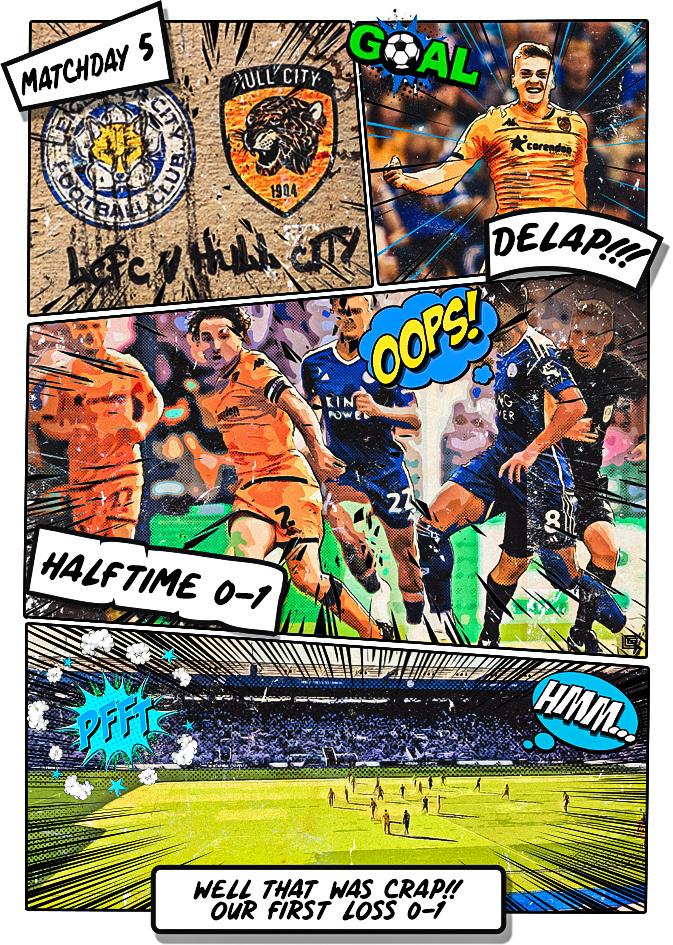

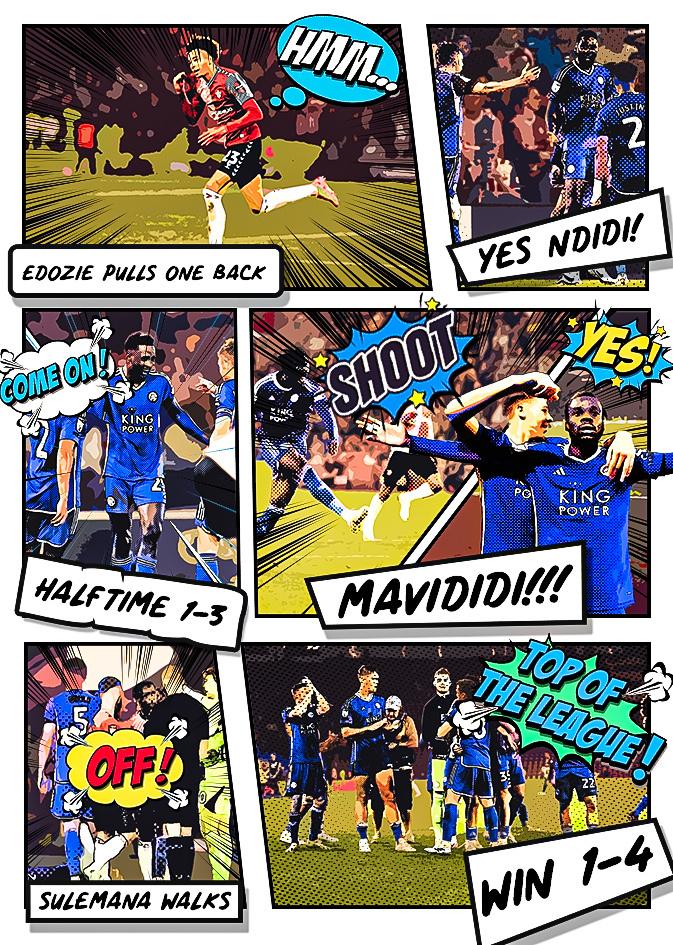
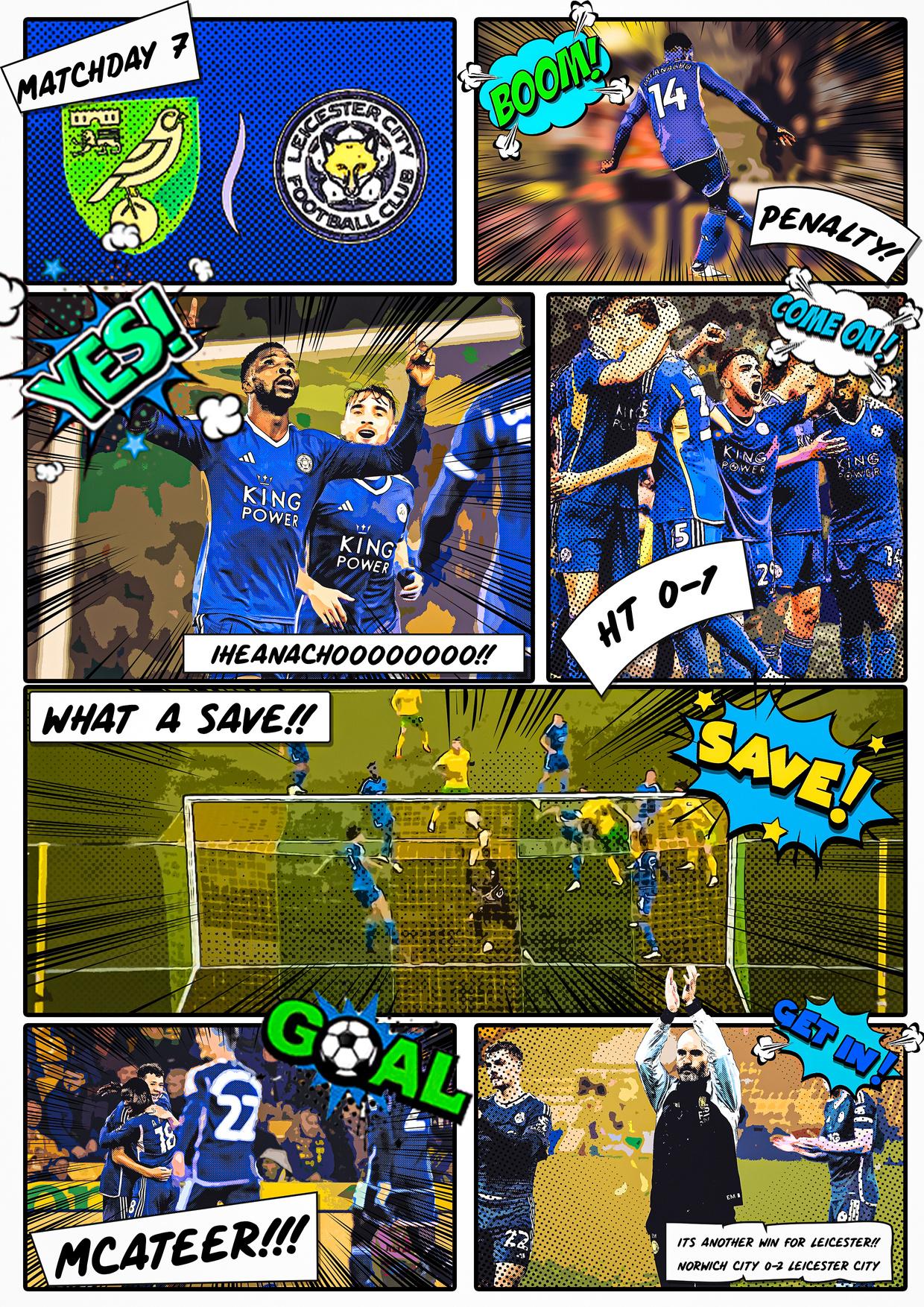
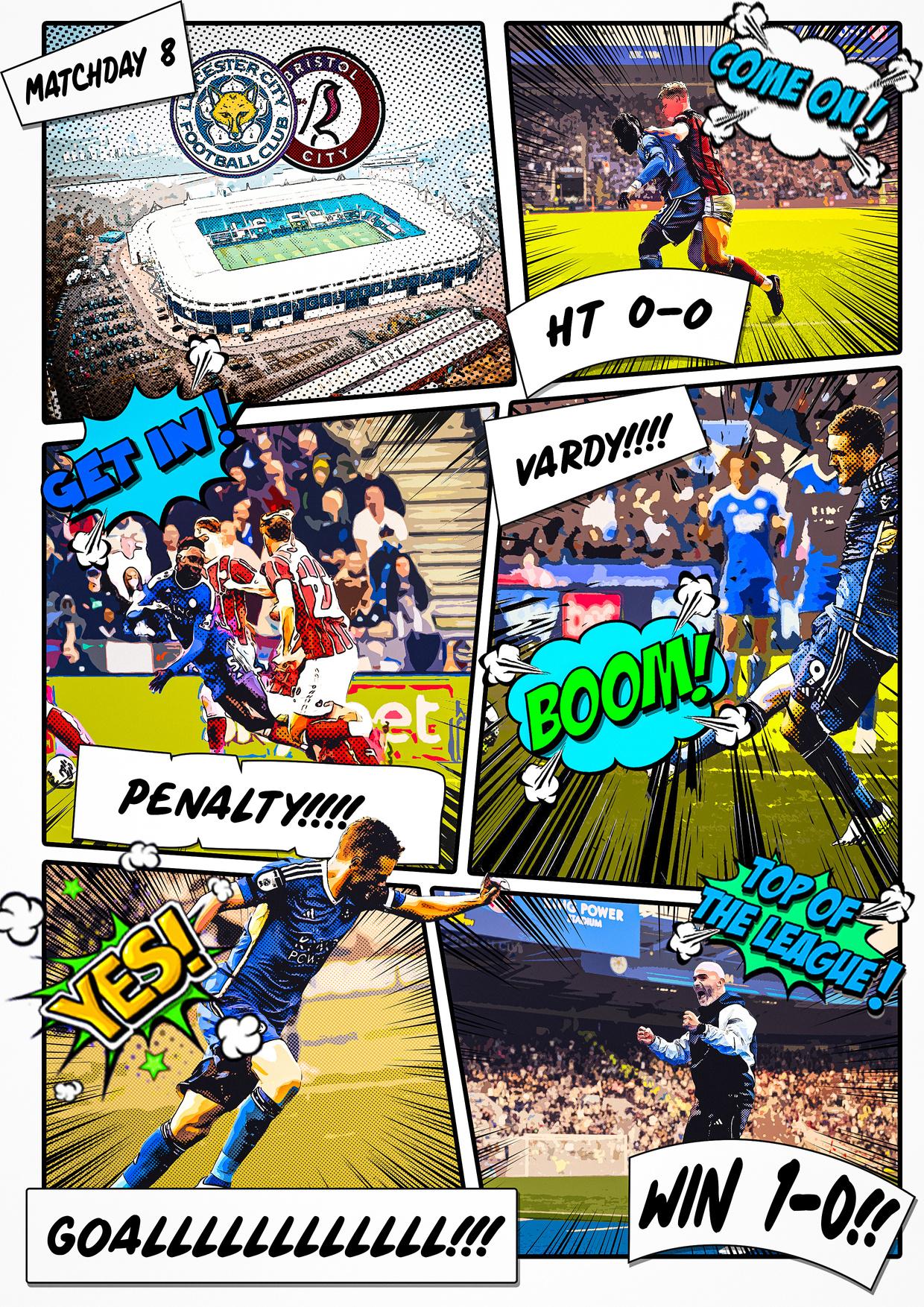

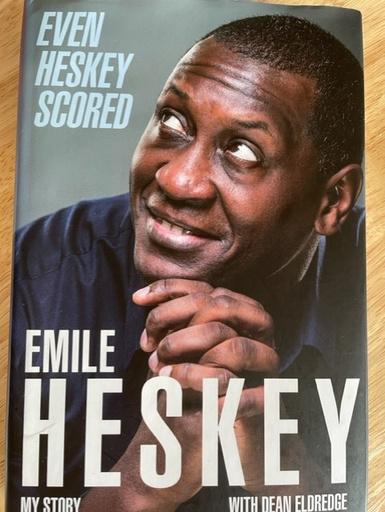 Emile Heskey/Dean Eldredge.
Emile Heskey/Dean Eldredge.
I doubt any of us who saw Emile in his early years at Filbert Street would question his ability. He was powerful and as quick as any striker, and if anything we thought he’d end up in the superstar bracket. He may not have quite reached that level, but he still had an impressive career, both at club and country level. Getting picked to play for England 62 times, and playing in two World Cups and two European Championships is a good achievement for any footballer. As Emile himself points out, he may have only scored seven goals for England, but it’s seven more than most people get to score. Plus, his striking colleagues, in particular Michael Owen, openly admit how much Mr Heskey helped in their success. So here we get to read the inside story of his football career, the highs and the lows, and the wide range of characters he met in the game.
It must be tempting when publishing a biography like this, to expose bad behaviour by fellow players, otherwise you are sugar-coating the truth. But by doing so you betray your fellow players, and no one likes the ex-colleague who grasses on your actions. Mr Heskey treads a middle ground here and earns respect by doing so. We hear about a lot of the crazy antics that footballers get up to, but for some of the more sordid actions, he doesn’t state which individual party is guilty. So for example, when he tells of the City squad getting extremely drunk on an overseas training visit, he doesn’t mention which team member got so sozzled he wet his pants on a training session. He does state however that everyone was either “pissed or halfway there”, which isn’t too hard to believe with a team including Lenny, Marshy and Walshy.
We already know that Emile Heskey didn’t spend his entire career at Leicester. He signed for Liverpool (a team he supported when young) and had a great footballing partnership with Michael Owen both at Pool and for England. We learn in the book why certain talented players failed to reach the heights, and the different ways football managers operated (both at club and at international level). It was a surprise to me to find out his favourite manager was Gerard Houllier. I was certain it would be Martin O’Neill (for whom he played for twice), but it seems not, although he has a lot of respect and affection for him, and indeed Martin writes the foreword for this biography. Other managers are covered in the book, including those he played for in the England team such as Sven, Kevin Keegan, Steve McClaren and Fabio Capello. If anything, Emile is perhaps a bit lenient in his description of different managers, and I suspect most players will err in caution when talking of managers as they don’t want to burn boats as regards future job opportunities.
There are plenty of football stories and memories in this publication, but Emile doesn’t shy away from talking about his private life and his personality, despite his acknowledged shyness. He admits that he prefers to stay at home rather than going out often, and in this he perhaps differs to many football stars and celebrities. He admits to feeling isolated and under pressure when first moving to Liverpool, but overcomes those feelings and eventually ends up living in the north-west even when playing for a Midlands team. There is also a section on the effects of racism, and how a lot more needs to be done to address this issue even if society has improved in certain ways. As Emile says, hate and discrimination still exist, and must be addressed; the problem is that as a nation we spend a lot of times talking about an issue but drag our feet in actually doing something about it.
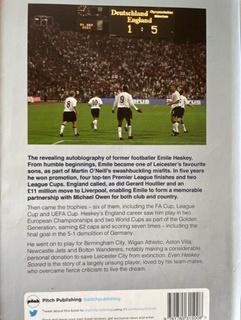
I enjoy reading footballer biographies (if they’re done well), but rarely re-read them. I did re-read this book, as I enjoyed the memories and insights that Emile has written down. Emile Heskey played quite a lot for the national team, as well as various English league teams, so we get to find out how several managers operated, as well as various stars and personalities in the game. Of course we are reading his version of events, but he comes across as a wellbalanced and decent individual.
Verdict: I can recommend this book to all Leicester fans of a certain age who remember the Martin O’Neill years. .
ISBN 9781785 315008
Throughout the history of Leicester City there have been many players that have stolen our hearts and made us daydream of them fondly as their contributions are warmly remembered.
A famous Argentinian rolled in for an unforgettable season before leaving Foxes fans heartbroken in 2015 after a very GREAT escape. The sadness of this exit was that it felt like a once in a generation opportunity. How wrong we all were. Hidden amongst a slew of summer signings and a new Italian manager, was a French central midfielder going by the name of N’Golo Kante, signed by Caen for a fee reported to be 5.6 million pounds.
His small stature and unassuming cameo at the end of the starting game of the season, a 4-2-win vs Sunderland had nobody out of their seats But within a few matches he had cemented his place in the starting eleven with performances that were proving more and more remarkable. He was seemingly impossible to avoid as he positioned himself perfectly to claw the ball back, making tackling into an artform as he won possession and fed a quick counter-attack to often capitalise on Jamie Vardy’s pace, who was making his own headlines.
Kante was a master of defensive midfield play, that hadn’t quite been honed going forward. His only goal came in a 2-1 victory at home to Watford. That was Kante’s only goal for the Foxes, but that was not a problem for him considering his main credentials were built in winning the football back. Much has been said about how good he was in this position. Many claimed he was like two players in one position with people as high in the game as Alex Ferguson lauding him with praise. His strength was forming a strong partnership with Danny Drinkwater who was also having the season of his life.
Not only was he extraordinary at winning the ball back, but he was incredibly strong on the ball and extremely difficult to dispossess as was demonstrated in significant games at Manchester City and Arsenal in February, the latter being the last time the team would taste defeat for the season.
The impossible came true as Leicester City romped to an unlikely and comfortable Premier League Title, still talked about as the greatest sporting achievement of all time. The debate then turned to who was the Premier League player of the season with Jamie Vardy, Riyad Mahrez and Kante all in the mix. For the record Jamie Vardy won it. But the football purists, the ones that like to look beneath the surface, the snobs if you will, tended to pip for the less obvious name of Kante.
For many, Kante’s contribution is un-paralleled, his influence on games and breaking up opposition attacks was crucial to allowing a team like Leicester to be so devastating on the counter-attack. Like a boxer soaking up attacking pressure with his arms up, Kante would deliver the crucial jab to knocking the opponent off balance before Mahrez or Vardy delivered the knock-out blow and leave teams on the floor seeing stars struggling to understand what just happened. He ended the season with the most tackles made in the Premier League that season (175) – more than 31 clear of Idrissa Gueye and a total that no other Premier League player has got near since.
After Kante lifted the trophy, he did the same thing Esteban Cambiasso did and left with good wishes, only this time Leicester got paid to the tune of 35 million pounds after a rare release clause was activated. Agents were also reportedly paid the princely sum of ten million pounds to make the deal happen which always seemed at the time (and now) like a conflict of interest and a motivator to unsettle a player.

The eventual destination of West London and Chelsea has made a habit of stealing Leicester players over recent years, and this is the only one where the player was warmly welcomed back. He could have given us another year in the Champions League on improved terms, but instead decided to leave for the bright lights of London, more money and no European football. I don’t begrudge him his big payday and ambitions of more silverware. He was criminally overlooked at Euro 2016 by Didier Deschamps for Moussa Sissoko which arguably cost them the tournament.
But why go to a club that epitomises everything that is wrong with football? Because he ended up winning a whole host of trophies for Roman Abramovich’s men for seven years. Another Premier League, FA Cup, The League Cup, A Europa League and a Champions League were added to his accolades. At the end of the 2016/2017 season, he was crowned the Premier League player of the season for doing the exact same job at Chelsea that he did at Leicester only surrounded by a stronger squad of players. The reason he left is he knew deep down that Leicester wouldn’t be given credit for their success and that they would struggle to replicate it, which would affect his career.
But to join Chelsea (the very epitome of football villainy) was like watching Han Solo donning a Darth Vader helmet and helping the enemy destroy the galaxy. Kante even had the temerity to score a long-range beauty against his former employers at The King Power one time, the cheeky git!
He kept in touch with players and would make regular trips back to the club. He is well-regarded as one of the nice guys in football, which is what makes his move to Chelsea even harder to swallow. At least he has left them now, for the more morally astute…. erm Saudi Arabia. Makes you wonder if N’Golo was as nice as they claimed But every Leicester fan would have him back in a heartbeat.


I am expecting some flack just for reviewing this book. It deals with the ‘casuals’ – the groups of football supporters who engaged in violence with other football gangs in the 80s, and other criminal activities, but also had a strong interest in fashion and music. The critics will claim that it’s just painting criminal behaviour in a good light. However, the author Riaz Khan will deny that he is trying to glorify what he and his gang members got up to, more that he’s trying to relate what they did and why. It’s not a book that tries to list story after story claiming their ‘firm’ or ‘squad’ always triumphed, but it does try to examine why they got involved in the scene, and some of the antics they got up to. Part of it was the excitement of going to the match, home and away, and pitting your clan’s fighting skills against those from another city. For people like Khan and others from an ethnic background it was a chance to feel part of a community, to belong, at a time when racist attitudes were prevalent. Indeed, part of what made Leicester’s “Baby Squad” unique in Britain at the time was the inclusion of Asian members in their hooligan gang.
Another attraction which is perhaps understated, is that young men could show their worth to fellow football fans by being loyal to the tribe. A common cry to others when facing a big gang was to “stand your ground”. A member of the football clan (I remember in the day they were called “squaddies” not “casuals”) despite not being talented in other areas, could gain respect from his peers by being able to stand up to the opposing forces.
One reason I found the accounts in this book very authentic, is that it covers a time when I went regularly to see Leicester play, home and away. I went to watch to football, and was not a member of the Baby Squad, but there were times I’d see them (and opposing gangs) in action. I used to go and watch Leicester play with others from Loughborough, and there were times when we were saved from a beating from opposition fans by the Baby Squad’s intervention. Although we were more on the “scarfer” spectrum, we were of an age that made us targets to opposition firms. Not that all the members of the squad were angels; many loved violence and it was quite common to see fights break out between fellow Leicester fans I also found out in this book what had really taken place at certain games. I had been amazed by the size of an Arsenal squad that had come to the city and rampage down the streets; I was then astounded to see an even bigger Leicester squad (far bigger than I’d ever seen) turn up and force the Arsenal mob to run off. I saw quite a few beatings that day that disgusted me, and I stopped going for a while after that. It was not until I read this book that I found out there was something called the Derby Leicester Alliance in place for a short period, and the Leicester numbers were swelled on that day by Derby fans from the Derby Lunatic Fringe (DLF). Given the numbers of hooligans around that day, it’s no wonder the police failed to stop so much violence kicking off. It has to be admitted that part of the appeal of the casuals’ movement at the time (and it’s described several times by contributors to this publication) is the exhilaration at seeing violence break out. Chelsea’s fans are mentioned several times, for being both belligerent and racist, yet there was always an air of expectancy when their team came to play at Filbert Street. Fights would break out in different parts of the ground, and there would be seemingly co-ordinated fireworks and flares let off, which gave an impression of “shock and awe”. The combination of fear, excitement and expectation made this type of violent outbreak oddly attractive to the youngsters caught up in it. One of the best aspects of this book is that Riaz gets various exmembers of the Baby Squad to contribute to the story, and they strive to give a honest account of their actions, and also that of rival firms. The media like to describe the people involved as being mindless thugs, but the reality is somewhat different.
I’m struck by how many of the contributors matured and went onto further education in later life. Many of them admit that certain followings, like West Ham, Everton and Chelsea were feared opponents, and more than one contributor admits that the Millwall following were nearly impossible to back down. There is also a sense of admiration by some of the Leicester following, at the ambush carried out by the Portsmouth 6:57 crew on the Baby Squad at a London venue. One thing to be ambushed by Spurs or Chelsea in London, but Portsmouth? A lot of the conflicts that kicked off would involve unequal numbers, and often the smaller squad fighting against a bigger mob could gain glory by overcoming the odds and pushing the aggressors back. There is also the claim, common with a lot of the football squads of the time, that they only “fought against their own kind”. The narrative was they avoided picking fights with the normal fans, known as “scarfers”. Although this was usually true, it wasn’t uniform behaviour. The books’ contributors are also painfully honest in describing how they managed to obtain their desired fashion clothing –normally by stealing or shoplifting.
For those who into this subject, the book describes how and when violence “kicked off”, and benefits from getting witness accounts from various members of the “Baby Squad” (the book also explains how there was really a collection of different street gangs in Leicester who came together under that label just for the football games). I suspect it’s one of the best books you can read if you want to understand the phenomenon. If it does lack anything, it’s input from the police involved, and how they struggled at the time to adjust to hooligan tactics. Certainly in the early 80s the average football fan, still less a casuals hooligan, had little respect for the police’s ability to predict and prevent football violence, but this changed later with the advent of cctv, technology and intelligence actions. That’s a different subject, however. Riaz Khan has put together a book that explains how he, and various other casuals, got involved in soccer violence and why they found that way of life appealing. Even today when they have chosen a law-abiding life, many of them will admit to missing those days. If you read the book you will get a good insight into why they miss the Baby Squad years.
Verdict: A fascinating read ISBN 978-0993430909
